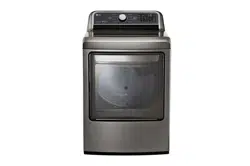Documents: Go to download!
User Manual
- User Manual - (English, Spanish)
- Specification - (English)
- PRODUCT OVERVIEW
- OPERATION
- MAINTENANCE
- TROUBLESHOOTING
Table of contents
Owner's Guide Dryer
PRODUCT OVERVIEW
Parts
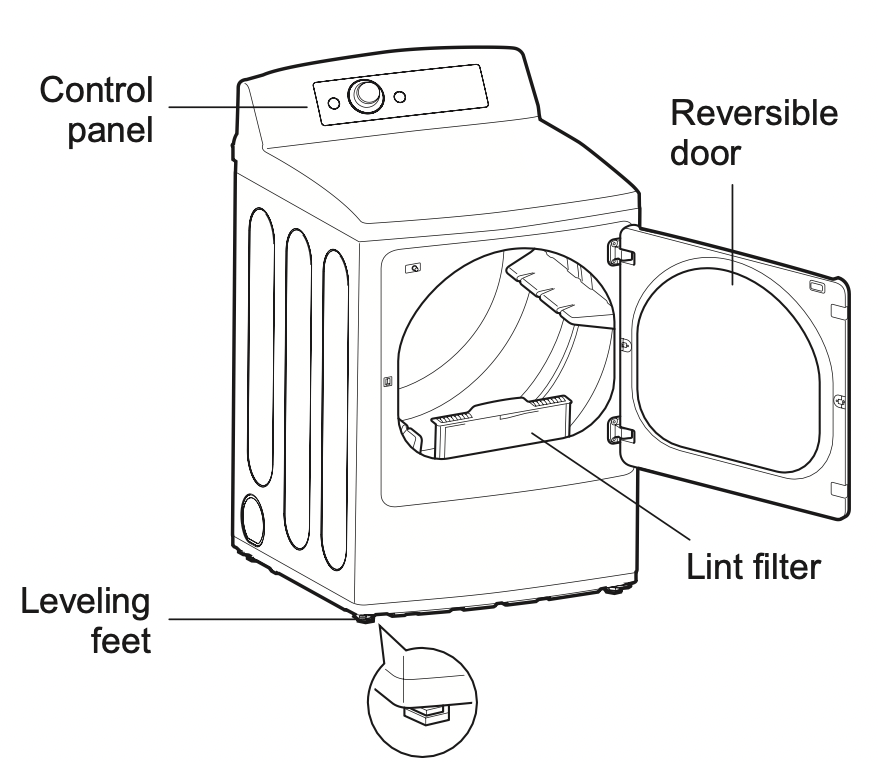
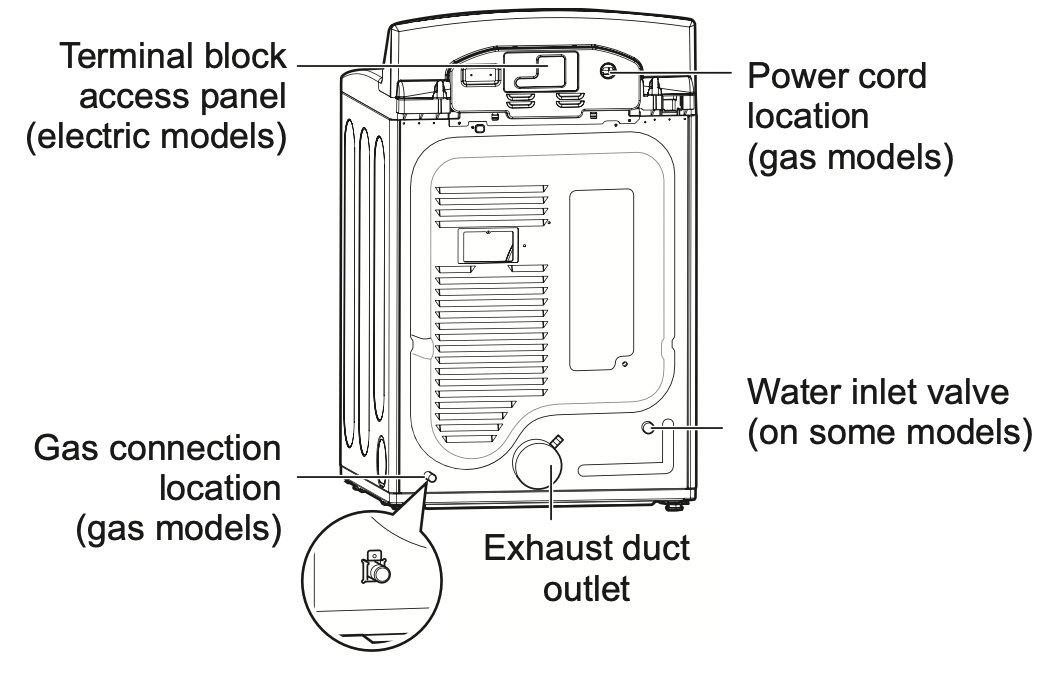
Accessories
Included Accessories
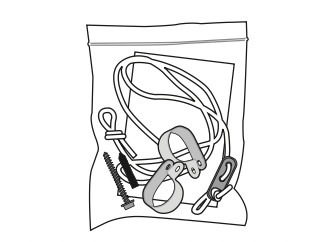
Safety Tether Kit (on some models)
Optional Accessories

Drying rack (sold separately) No. 3750EL0001C
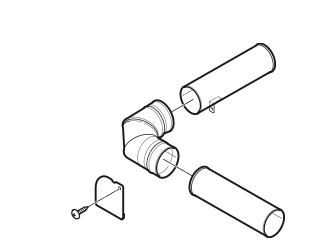
Side vent kit (sold separately) Kit No. 383EEL9001B
Two-Way Reversible Door (on some models)

The LG EasyLoad™ feature allows you to open the dryer door from the top, hamper-style, when loading the dryer to help guide clothes into the drum and prevent them from falling onto the floor. When unloading the dryer or loading bulkier items, use the swing door for easy access to the drum.
Safety Tether Kit
This optional kit helps prevent the dryer tipping if children climb on the door or if someone should fall onto the door. It is recommended that you install this kit, depending on your situation, but it is not required. Follow the customer installation instructions included with the kit to properly install the kit. If you do not install the kit, store it out of reach of children.
NOTE
- For your safety and for extended product life, use only authorized components. The manufacturer is not responsible for product malfunction or accidents caused by the use of separately purchased unauthorized components or parts.
- The images in this guide may be different from the actual components and accessories, which are subject to change by the manufacturer without prior notice for product improvement purposes.
OPERATION
WARNING: To reduce the risk of fire, electric shock, or injury to persons, read this entire manual, including the IMPORTANT SAFETY INSTRUCTIONS, before operating this dryer.
Using the Dryer
- Clean the Lint Filter
If the lint filter has not already been cleaned, lift out the filter and remove the lint from the last load. This will help ensure the fastest and most efficient drying performance. Make sure to reinstall the filter, pressing down until it clicks firmly into place. The dryer will not operate without the lint filter in place.

- Load the Dryer
See other models: 65UV340H DLG3744D PJ2B 22LS3500 LFXS32736D
Load the dryer with the wet laundry from the washer. If the load is extra large, you may need to divide it into smaller loads for proper performance and fabric care.

- Turn on The Dryer
Press the POWER button to turn ON the dryer. The cycle LEDs will illuminate and a chime will sound.
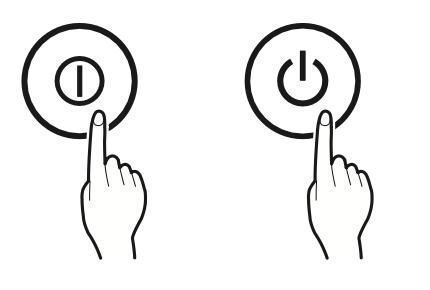
- Select a Cycle
Turn the cycle selector knob in either direction until the LED for the desired cycle is on. The preset temperature, dry level, and option settings for that cycle will be shown. Default settings for the selected cycle can now be changed if desired. Refer to the Cycle Setting and Options page for details.

NOTE: Not all options or modifiers are available on all cycles. A different chime will sound and the LED will not come on if the selection is not allowed. - Begin the Cycle
Press the START/PAUSE button to begin the cycle. The cycle can be paused at any time either by opening the door or by pressing the START/PAUSE button. If the cycle is not restarted within 60 minutes of being paused, the dryer will shut off and the settings will be lost.
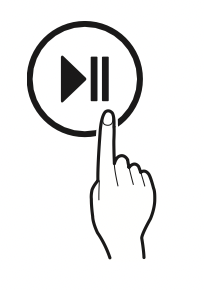
- End of Cycle
When the cycle is finished, the chime will sound. Immediately remove your clothing from the dryer to reduce wrinkling. If Wrinkle Care is selected, the dryer will tumble briefly every few minutes to help prevent wrinkles from setting in the clothes.
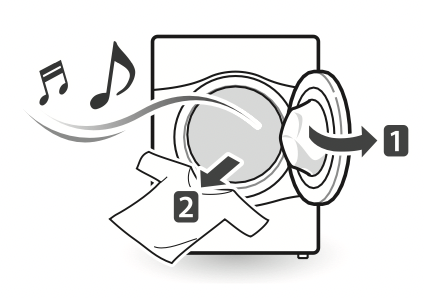
Check the Lint Filter Before Every Load
Always make sure the lint filter is clean before starting a new load; a clogged lint filter will increase drying time. To clean, pull the lint filter straight up and roll any lint off the filter with your fingers. Do not rinse or wash the filter to remove lint. Push the lint filter firmly back into place. See Regular Cleaning for more information.
Always ensure the lint filter is properly installed before running the dryer. Running the dryer with a loose or missing lint filter will damage the dryer and articles in the dryer.

Sorting Loads
Fabric Care Labels
Most articles of clothing feature fabric care labels that include instructions for proper care.
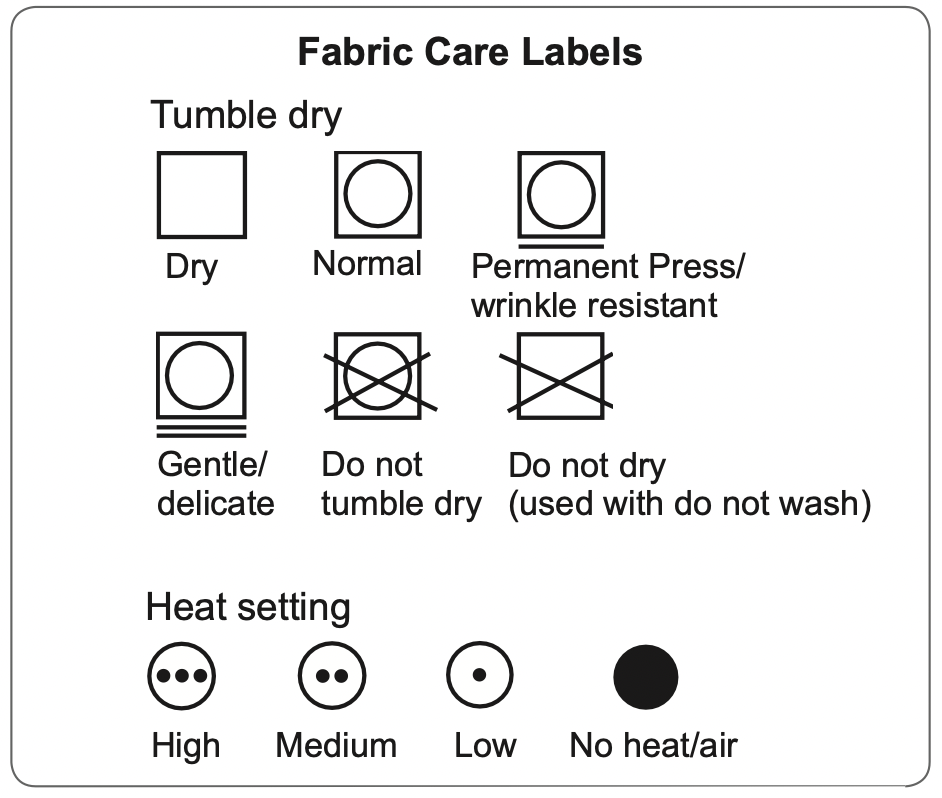
Group Similar Items
For best results, sort clothes into loads that can be dried with the same drying cycle.
Different fabrics have different care requirements, and some fabrics will dry more quickly than others. For best fabric care results, always dry fabrics with similar care requirements together.
Loading the Dryer
WARNING
To reduce the risk of fire, electric shock, or injury to persons when using this appliance, follow basic precautions, including the following:
- Check all pockets to make sure that they are empty. Items such as clips, pens, coins, and keys can damage both your dryer and your clothes. Flammable objects such as lighters or matches could ignite, causing a fire. Failure to do so may result in fire, explosion, or death.
- Never dry clothes that have been exposed to oil, gasoline, or other flammable substances. Washing clothes will not completely remove oil residues. Failure to obey this warning may result in fire, explosion, or death.
NOTE
Loading Tips
- Combine large and small items in the same load.
- Damp clothes will expand as they dry. Do not overload the dryer; clothes require room to tumble and dry properly.
- Close zippers, hooks, and drawstrings to prevent these items from snagging or tangling on other clothes.
Using the LG EasyLoadTM
Swing Door
Use the swing door when unloading, or when loading bulkier items, for easy access to the drum.
To open the swing door, grasp the top of the door on the side opposite the hinge and pull.
NOTE: Make sure the hamper door release is completely closed before using the swing door.
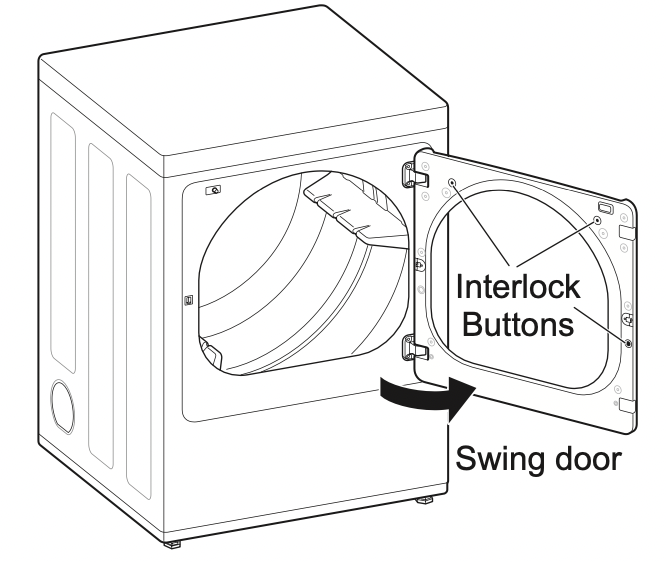
WARNING
Do not press the three interlock buttons when the door is open. The door may fall off and cause serious injury.
- Do not place heavy items on or lean against the top of the door when it is open.
The dryer could tip forward, causing injury or property damage.
Hamper Door (on some models)
Use the hamper door when loading. The hamper door opens about 40 degrees and acts as a chute to help guide items into the drum and help prevent items from falling onto the floor. It also comes in handy when unloading a few small items, helping prevent the rest of the laundry from being pulled onto the floor.
To open the hamper door, press the release on the top of the door and pull the door forward.
Make sure laundry is fully inserted in the drum before closing the door.
NOTE: Make sure the swing door latch is completely closed before pressing the hamper door release.

WARNING
- Do not attempt to pull the hamper door open more than 40 degrees.
- Be careful when opening and closing the door.
Fingers and hands can get caught in the door and cause injury if the door drops forward unexpectedly.
Control Panel
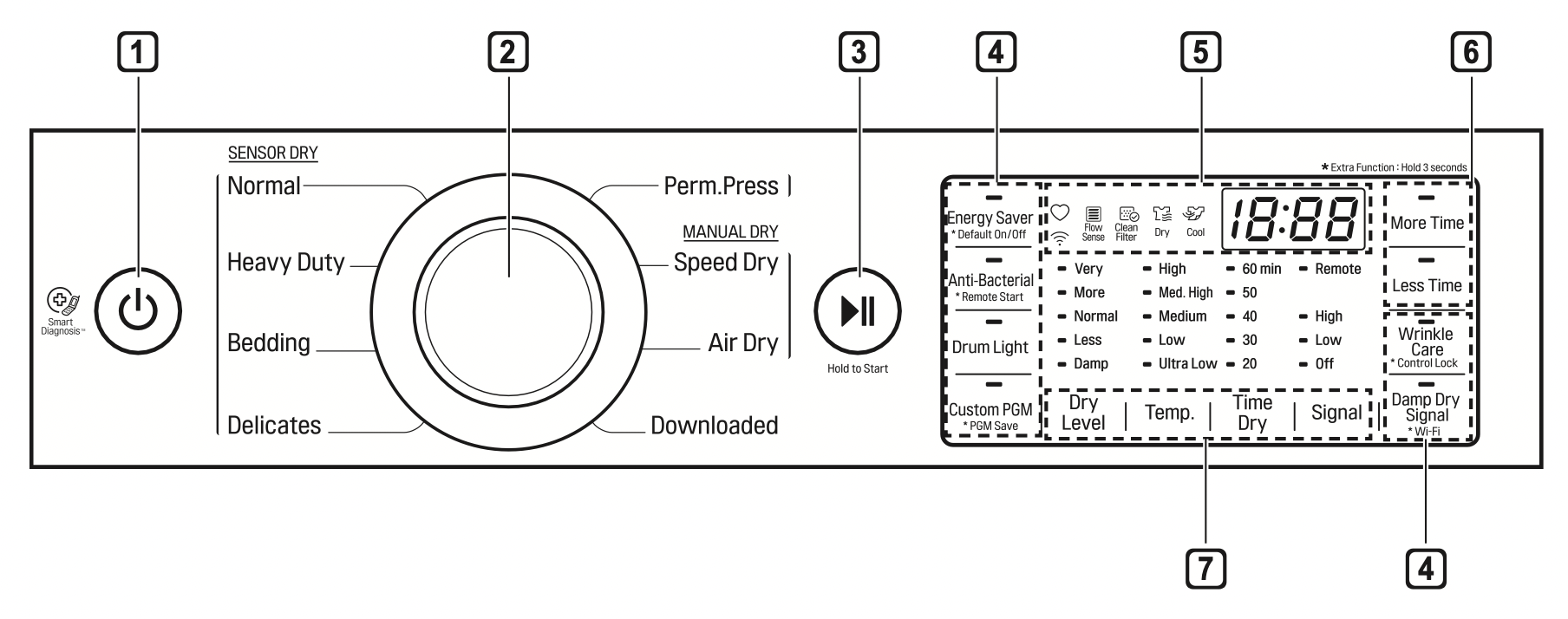
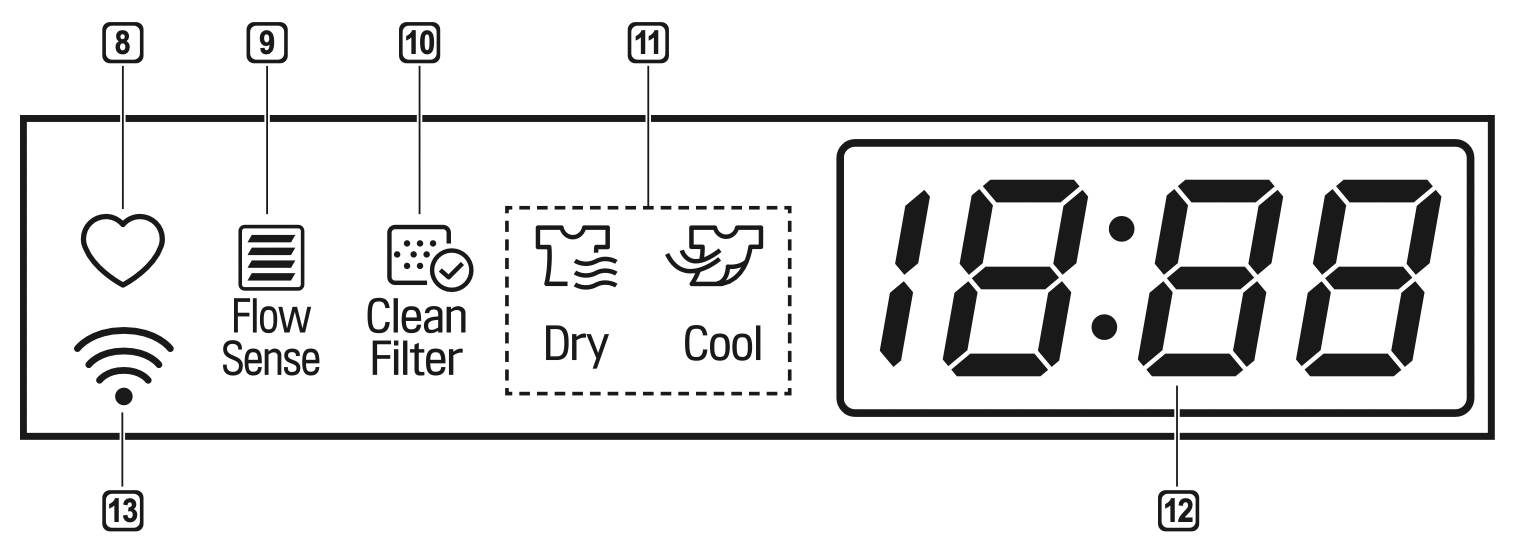
- POWER
Button Press to turn the dryer ON. Press again to turn the dryer OFF.
NOTE: Pressing the POWER button during a cycle will cancel that cycle and any load settings will be lost. - Cycle Selector Knob
Turn this knob to select the desired cycle. Once the desired cycle has been selected, the standard presets are shown in the display. On Manual Dry cycles, these settings can be adjusted using the cycle modifier buttons any time before starting the cycle. - START/PAUSE Button
Press this button to start the selected cycle. If the dryer is running, use this button to pause the cycle without losing the current settings.
NOTE: If you do not press the START/PAUSE button to resume a cycle within 60 minutes, the dryer turns off automatically. - Cycle Option Buttons
The option buttons allow you to select additional cycle options. Certain buttons also allow you to activate special functions by pressing and holding the button for 3 seconds. - Time and Status Display
The display shows the settings, estimated time remaining, options, and status messages for the dryer. - MORE TIME/LESS TIME Buttons
Use these buttons with the Time Dry and other Manual Dry cycles to adjust the drying time. Press the MORE TIME button to increase the selected manual cycle time by 1 minute; press the LESS TIME button to decrease the cycle time by 1 minute. - Cycle Modifier Buttons
Use these buttons to select the desired cycle settings for the selected cycle. The current settings are shown in the display. Press the button for that modifier to select other settings. - Custom PGM
If you have a special combination of settings that you use frequently, you can save these settings as a Custom Program. - Flow Sense ™ Duct Blockage Sensing System Indicator
The Flow Sense™ duct blockage sensing system detects and alerts you to blockages in the ductwork that reduce exhaust flow from the dryer. Maintaining a clean exhaust system improves operating efficiency and helps minimize service calls, saving you money. - Clean Filter Reminder
The display will show Clean Filter when the dryer is turned on as a reminder to check the filter. It turns off when the START/PAUSE button is pressed. - Cycle Completion Indicator with Check Filter Reminder
This portion of the display shows which stage of the drying cycle is currently underway (Dry, Cool). - Estimated Time Remaining
This display shows the estimated time remaining for SENSOR DRY cycles or the actual time remaining for Time Dry or MANUAL DRY cycles.
NOTE: The cycle time on SENSOR DRY cycles may fluctuate as the dryer recalculates drying time for optimal results. - WI-FI Indicator
When the appliance is connected to the internet through a home Wi-Fi network, this indicator appears.
Cycle guide
 = default setting
= default setting
 = allowable option
= allowable option

Sensor dry cycles
Sensor dry cycles utilize LG’s unique dual sensor system to detect and compare the moisture level in clothes and in the air and adjust the drying time as needed to ensure superior results. The dryer automatically sets the dryness level and temperature at the recommended setting for each cycle. The estimated time remaining will be shown in the display.
NOTE: To protect your garments not every dryness level, temperature, or option is available with every cycle. See the Cycle guide for details.
Downloaded
If you download a cycle using the Smart ThinQ application, it will be placed in the downloaded cycle position. Choose the Downloaded cycle to run the downloaded cycle.
Manual dry cycles
UseI manual dry cycles to select a specific amount of drying time and a drying temperature. When a manual dry cycle is selected, the Estimated Time I Remainng display shows the actual time remaining in your cycle. You can change the actual time in the cycle by pressing More Time or Less Time.
Cycle Settings and Options
Cycle Modifier Buttons
SENSOR DRY cycles have preset settings that are selected automatically. MANUAL DRY cycles have default settings, but you may also customize the settings using the cycle modifier buttons. Press the button for that option to view and select other settings.
Dry Level
Selects the level of dryness for the cycle. Press the Dry Level button repeatedly to scroll through available settings.
- This option is only available with SENSOR DRY cycles.
- The dryer will automatically adjust the cycle time. Selecting More Dry or Very Dry will increase the cycle time, while Less Dry or Damp Dry will decrease the cycle time.
- Use a Less Dry or Damp Dry setting for items that you wish to iron.
Temp.
Adjusts the temperature setting. This allows precise care of your fabrics and garments. Press the Temp. button repeatedly to scroll through available settings.
Time Dry
Allows you to manually select the drying time, from 20 to 60 minutes, in 10-minute increments. Use this for small loads or to remove wrinkles.
More Time/Less Time
Use the More Time/Less Time buttons to add or reduce the drying time of a MANUAL DRY cycle in 1-minute increments.
Signal (Option)
Press the Signal (Option) button repeatedly to change the volume or turn on/off the button tones and the end of cycle melody.
Cycle Option Buttons
The dryer features several additional cycle options to customize cycles to meet individual needs. Certain option buttons also feature a special function that can be activated by pressing and holding that option button for 3 seconds. (See Special Functions on the following page for details.)
Adding Cycle Options to a Cycle:
- Turn on the dryer and turn the cycle selector knob to select the desired cycle.
- Use the cycle modifier buttons to adjust the settings for that cycle.
- Press the cycle option button(s) for the option you would like to add. A confirmation message is shown in the display.
- Press the START/PAUSE button to start the cycle. The dryer starts automatically.
Wrinkle Care
Selecting this option will tumble the load periodically for up to 3 hours after the selected cycle, or until the door is opened. This is helpful in preventing wrinkles when you are unable to remove items from the dryer immediately.
Damp Dry Signal
With this option, the dryer will signal when the load is approximately 80% dry. This allows you to remove faster- drying lightweight items or items that you would like to iron or hang while still slightly damp.
Special Functions
Some cycle option buttons also activate secondary functions. These special functions are marked with an asterisk (*). Press and hold the option button marked with the special function to activate it.
Drum Light
The drum is equipped with a blue LED that illuminates when the dryer is turned on. This light automatically turns off when the door is closed and the cycle starts. To turn on the light during a cycle, press the Drum Light button. The drum light will illuminate and then turn off automatically after four minutes.
* Control Lock
Use this option to prevent unwanted use of the dryer or to keep cycle settings from being changed while the dryer is operating.
Press and hold the button marked Control Lock for 3 seconds to activate or deactivate the Control Lock function. The Control Lock icon will be shown in the display, and all controls will be disabled except the POWER button.
NOTE: Once set, Control Lock remains active until it is manually deactivated. Control Lock must be turned off to run another cycle. To deactivate Control Lock, press and hold the Control Lock button for 3 seconds.
Energy Saver (on some models)
This option helps to reduce energy consumption in the Normal cycle, depending on the load size. When the Energy Saver option is selected, the cycle begins with an air dry section and the drying time is increased.
NOTE: The Energy Saver option is turned on by default in the Normal cycle. Turn off the Energy Saver option for a faster Normal cycle which begins with heated drying.
* Default On/Off
This option allows the Energy Saver settings to be changed. To run a Normal cycle without the Energy Saver option, press and hold the Energy Saver button for three seconds. ON or OFF appears in the display.
Custom PGM
If you have a special combination of settings that you use frequently, you can save these settings as a custom program.
Saving a Custom Program:
- Turn on the dryer and turn the cycle selector knob to select the desired cycle.
- Use the cycle setting buttons to adjust the settings for that cycle.
- Press the cycle option button(s) for the option you would like to add. A confirmation message will be shown in the display.
- Press and hold the Custom PgM button for 3 seconds.
NOTE: You may save only one custom program at a time. Pressing and holding the Custom PgM button will overwrite any previously saved custom program.
Recalling a Custom Program:
- Turn on the dryer.
- Press the Custom PgM button.
- Press the START/PAUSE button to start the cycle.
MAINTENANCE
Regular Cleaning
WARNING
To reduce the risk of fire, electric shock, or injury to persons when using this appliance, follow basic precautions, including the following:
- Unplug the dryer before cleaning to avoid the risk of electric shock. Failure to follow this warning may cause serious injury, fire, electric shock, or death.
- Never use harsh chemicals, abrasive cleaners, or solvents to clean the washer. They will damage the finish.
Cleaning the Exterior
Proper care of your dryer can extend its life. The outside of the machine can be cleaned with warm water and a mild, nonabrasive household detergent. Immediately wipe off any spills with a soft, damp cloth.
NOTE
- Do not use methylated spirits, solvents, or similar products.
- Never use steel wool or abrasive cleansers; they can damage the surface.
Cleaning the Interior
Wipe around the door opening and seal with a soft, damp cloth to prevent lint and dust buildup that could damage the door seal.
Clean the window with a soft cloth dampened with warm water and a mild, nonabrasive household detergent, then wipe dry.
The stainless steel drum can be cleaned with a conventional stainless steel cleaner, used according to the manufacturer’s specifications. Never use steel wool or abrasive cleansers; they may scratch or damage the surface.
Cleaning Around and Under the Dryer
Vacuum lint and dust from around the dryer and underneath it regularly. Vent ductwork should be checked for lint buildup and cleaned at least once per year. If any noticeable reduction in airflow or drying performance occurs, immediately check ductwork for obstructions and blockages.
Maintaining Ductwork
Vent ductwork should be checked for lint buildup once per month and cleaned at least once per year. If any noticeable reduction in airflow or drying performance occurs, immediately check ductwork for obstructions and blockages. Contact a qualified technician or service provider.
Cleaning the Lint Filter
Always clean the lint from the filter after every cycle.

To clean, open the dryer door and pull the lint filter straight up. Then:
- For everyday cleaning, roll any lint off the filter with your fingers, or
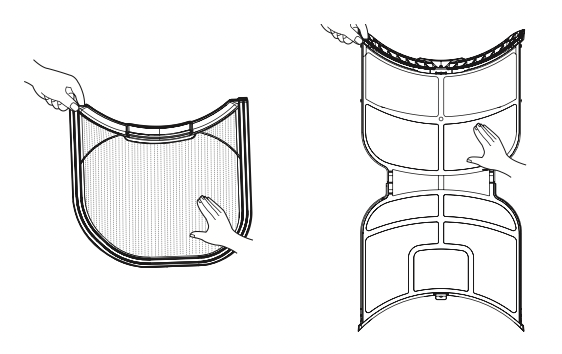
- Vacuum the lint filter.
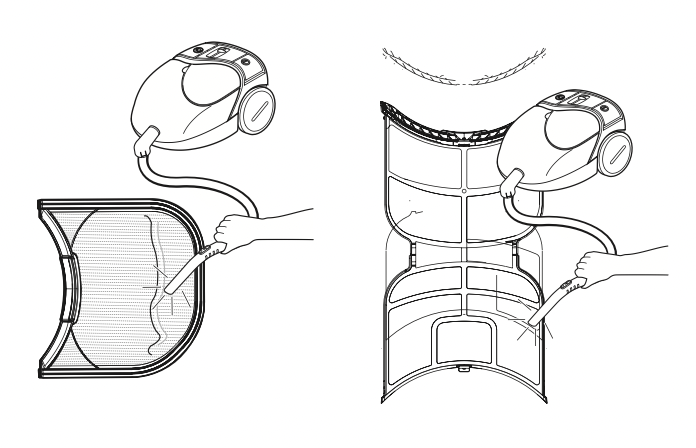
- If the lint filter has become very dirty or clogged with fabric softener, wash the lint filter in warm, soapy water and allow it to dry thoroughly before reinstalling.
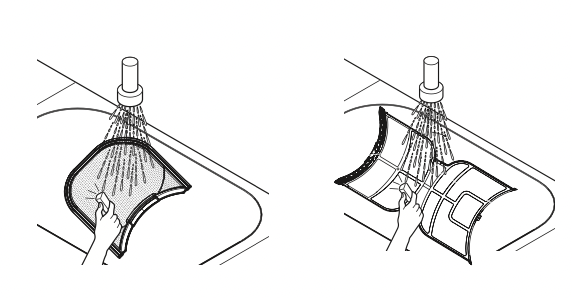
NOTE: NEVER operate the dryer without the lint filter in place. NEVER operate the dryer with a wet lint filter.
TROUBLESHOOTING
FAQs: Frequently Asked Questions
Q: When I press a button, why does my dryer beep and then nothing happens?
A: The Control Lock feature is turned on. To turn off Control Lock, turn the dryer on, then press and hold the button that has *Control Lock on or under it for 3 seconds.
Q: Why does my dryer take so long to dry clothes?
A: Proper airflow is critical to the efficient operation of clothes dryers. A lint filter which is full of lint or clogged with fabric softener sheet residue can reduce the airflow to the point that the time required to dry clothing will be greatly increased. Another factor affecting dry time is your home exhaust system. An exhaust system which is dirty and clogged with lint, or is excessively long, needs to be professionally cleaned or repaired.
Q: Why does my dryer start by itself every few minutes?
A: This is how the Wrinkle Care feature works. The dryer runs briefly every few minutes for up to 3 hours after the cycle finishes. This feature is designed to help prevent wrinkles from setting in when the dryer is not unloaded immediately after the cycle is finished.
Before Calling for Service
This dryer is equipped with an automatic error-monitoring system to detect and diagnose problems at an early stage. If the dryer does not function properly or does not function at all, check the following before you call for service.
Operation
| Problem |
Possible Cause |
Solutions |
|---|---|---|
|
The Flow SenseTM indicator remains active after clearing the restriction in the venting. |
After clearing the restriction, the Flow SenseTM system requires multiple, consecutive cycles to determine that the performance value has improved before the Flow SenseTM indicator isreset. |
If the Flow SenseTM indicator remains active for more than five cycles after the restriction has been cleared, call for service. |
|
Dryer will not turn on |
Power cord is not properly plugged in. |
Make sure that the plug is securely plugged into a grounded outlet matching the dryer’s rating plate. |
|
House fuse is blown, circuit breaker has tripped, or power outage has occurred. |
Reset circuit breaker or replace fuse. Do not increase fuse capacity. If the problem is a circuit overload, have it corrected by a qualified electrician. |
|
|
Dryer does not heat |
House fuse is blown, circuit breaker has tripped, or power outage has occurred. |
Reset circuit breaker or replace fuse. Do not increase fuse capacity. If the problem is a circuit overload, have it corrected by a qualified electrician. NOTE: Due to the design of electric dryers, it is possible for a circuit problem to allow an electric dryer to run without heat. |
|
Gas supply or service is turned off (gas models only). |
Confirm that the house gas shut off and the dryer gas shut off valves are both fully open. Even if gas is not supplied to the dryer, it will run and display error code. Verify that other gas appliances in the home are working normally. |
|
|
Energy Saver option selected (on some models) |
If using the Cotton/Normal cycle, deselect the energy saver option. The Energy Saver option is selected by default. This option reduces energy use by adding an air dry section to the beginning of the cycle. It is normal to feel no heat at the beginning of the cycle while in Energy Saver mode. |
|
|
Display show error code nP |
Electric dryer power cord is not connected correctly, or house power supply is incorrect. |
Check the power supply or the connection of the power cord to the terminal block. |
|
Display show error code gAS |
Gas supply or service turned off (gas models only). |
Confirm that house gas shutoff and the dryer gas shutoff are both fully open. |
|
Clothes take too long to dry |
Exhaust ducts are blocked, dirty, or duct run is too long. |
Confirm that the exhaust duct is properly configured and free of debris, lint, and obstructions. Make sure that outside wall dampers can open properly and are not blocked, jammed, or damaged. |
|
Load is not properly sorted. |
Separate heavy items from light weight items. Larger and heavier items take longer to dry. Light items in a load with heavy items can fool the sensor because the light items dry faster. |
|
|
Clothes take too long to dry |
Large load of heavy fabrics. |
Heavy fabrics take longer to dry because they tend to retain more moisture. To help reduce and maintainmore consistent drying times for large and heavy fabrics, separate these items into smaller loads of a consistent size. |
|
Dryer controls are not set properly. |
Use the appropriate control settings for the type of load you are drying. Some loads may require an adjustment of the dry level setting for proper drying. |
|
|
Lint filter needs to be cleaned. |
Remove the lint from the filter before every load. With the lint removed, hold the filter up to a light to see if it is dirty or clogged. With some loads that produce high amounts of lint, such as new bath towels, it may be necessary to pause the cycle and clean the filter during the cycle. |
|
|
House fuse is blown, circuit breaker has tripped, or power outage has occurred. |
Reset circuit breaker or replace fuse. Do not increase fuse capacity. If the problem is a circuit overload, have it corrected by a qualified electrician. NOTE: Due to the design of electric dryers, it is possible for a circuit problem to allow an electric dryer to run without heat. |
|
|
Dryer is overloaded. |
Divide extra large loads into smaller loads for better drying performance and efficiency. |
|
|
Dryer is under loaded. |
If you are drying a very small load, add a few extra items to ensure proper tumbling action. If the load isvery small and you are using SENSOR DRY cycles, the electronic control cannot properly sense the dryness of the load and may shut off too soon. Use TIME DRY or add some extra wet clothes to the load. |
|
|
Clothes take too long to dry |
Energy Saver option selected (on some models) |
If using the Cotton/Normal cycle, deselect the Energy Saver option. This option reduces energy use by adding an air dry section to the beginning of the cycle. |
|
Drying time is not consistent |
Heat settings, loadsize, or dampness of clothing is not consistent. |
The drying time for a load will vary depending on the type of heat used (electric, natural gas, or LP gas), the size of the load, the type of fabrics, the wetness of the clothes, and the condition of the exhaust duct and lint filter. Even an unbalanced load in the washer can cause poor spinning, resulting in wetter clothes which will take longer to dry. |
Performance
| Problem | Possible Cause |
Solutions |
|---|---|---|
|
Greasy or dirty spots on clothes |
Fabric softener used incorrectly. |
Confirm and follow the instructions provided with your fabric softener. |
|
Clean and dirty clothes are being dried together. |
Use your dryer to dry only clean items. Soil from dirty clothes can transfer to the clean clothes in the same or later loads. |
|
|
Clothes were not properly cleaned or rinsed before being placed in the dryer. |
Stains on dried clothes could be stains that were not removed during the washing process. Make sure that clothes are being completely cleaned or rinsed according to the instructions for your washer and detergent. Some difficult soils may require pre-treating prior to washing. |
|
|
Clothes are wrinkled |
Clothes dried too long (overdried). |
Over drying a load of laundry can lead to wrinkled clothes. Try a shorter drying time or LESS DRYsetting and remove items while they still retain a slight amount of moisture. |
|
Clothes left in dryer too long after cycle ends. |
Use the WRINKLE CARE option. This feature will tumble the clothes briefly every few minutes for up to 3 hours to help prevent wrinkling. |
|
|
Clothes are shrinking |
Garment care instructions are not being followed. |
To avoid shrinking your clothes, always consult and follow fabric care instructions. Some fabrics will naturally shrink when washed. Other fabrics can be washed but will shrink when dried in a dryer. Use alow or no heat setting. |
|
Lint on clothes |
Lint filter not cleaned properly. |
Remove the lint from the filter before every load. With the lint removed, hold the filter up to a light tosee if it is dirty or clogged. If it looks dirty, follow the cleaning instructions. With some loads that produce high amounts of lint, it may be necessary to clean the filter during the cycle. |
|
Laundry not sorted properly. |
Some fabrics are lint producers (i.e., a fuzzy white cotton towel) and should be dried separately from clothes that are lint trappers (i.e., a pair of black linen pants). |
|
|
Lint on clothes |
Excess static inclothes. |
Use a fabric softener to reduce static electricity. Be sure to follow the manufacturer’s instructions. Over drying a load of laundry can cause a buildup of static electricity. Adjust settings and use a shorter drying time, or use SENSOR DRY cycles. |
|
Dryer is overloaded. |
Divide extra large loads into smaller loads for drying. |
|
|
Tissue, paper,etc., left in pockets. |
Check pockets thoroughly before washing and drying clothes. |
|
|
Excess static in clothes after drying |
Fabric softener isnot used or usedincorrectly. |
Use a fabric softener or the STATIC SHIELD option, if equipped, to reduce static electricity. Be sure to followthe manufacturer’s instructions. |
|
Clothes dried too long (over dried). |
Overdrying a load of laundry can cause a buildup of static electricity. Adjust settings and use a shorter drying time, or use AUTO DRY cycles. Select a LESS DRY setting on SENSOR DRY cycles, if necessary. |
|
|
Drying synthetics, permanent press, or synthetic blends. |
These fabrics are naturally more prone to static buildup. Try using fabric softener, or use LESS DRY and/or shorter TIME DRY time settings. |
|
|
Clothes have damp spots after a SENSORDRY cycle. |
Very large load or very small load. Single large item such as a blanket or comforter. |
If items are too tightly packed or too sparse the sensor may have trouble reading the dryness level of the load. Use a Time Dry cycle for very small loads. Large, bulky items such as blankets or comforters can sometimes wrap themselves into a tight ball of fabric.The outside layers will dry and register on the sensors, while the inner core remains damp. When drying a single bulky item, it may help to pause the cycle once or twice and rearrange the item to unwrap and expose any damp areas. To dry a few remaining damp items from a very large load or a few damp spots on a large item after a sensor cycle has completed, empty the lint trap, then set a Time Dry cycle to finish drying the item(s). |
Error Codes
| Problem |
Possible Cause |
Solutions |
|---|---|---|
|
Error code: tE1 through tE7 |
Temperature sensor failure. |
Turn off the dryer and call for service. |
|
Display shows error code: PS (electric dryers only) |
Power cord is connected incorrectly. |
Check the connection of the power cord to the terminal block. |
|
*Flow SenseTM indicator shows four bars during the drying cycle or the display shows "d80" after drying * This warning light is not a dryer failure and is not covered by the dryer warranty. Contact a duct cleaning service to set up an appointment to have your exhaust system cleaned and inspected. |
Exhaust system is too long or has too many turns/restrictions. Partial blockage of the ductwork due to lint buildup or other foreign object. The appliance has detected a restriction in the external dryer venting. |
Install a shorter or straighter duct run. See the Installation Instructions for details. Ductwork should be checked/cleaned immediately. Dryer can be used in this condition, but drying times will be longer and energy consumption will increase. If exhaust restrictions are sensed by the Flow SenseTM system, the indicator will remain on for 2 hours after the end of the cycle. Opening the door or pressing the POWER button will turn off the display. |
| The Flow SenseTM indicator remains active after clearing the restriction in the venting. |
After clearing the restriction, the Flow SenseTM system requires multiple, consecutive cycles to determine that the performance value has improved before the Flow SenseTM indicator is reset. |
If the Flow SenseTM indicator remains active for more than five cycles after the restriction has been cleared, call for service. |
|
indicator light is on during the drying cycle |
Lint filter not cleaned properly. |
Remove the lint from the filter before every load. With the lint removed, hold the filter up to a light to see if it is dirty or clogged. If it looks dirty, follow the cleaning instructions. With some loads that produce high amounts of lint, it may be necessary to clean the filter during the cycle. |

